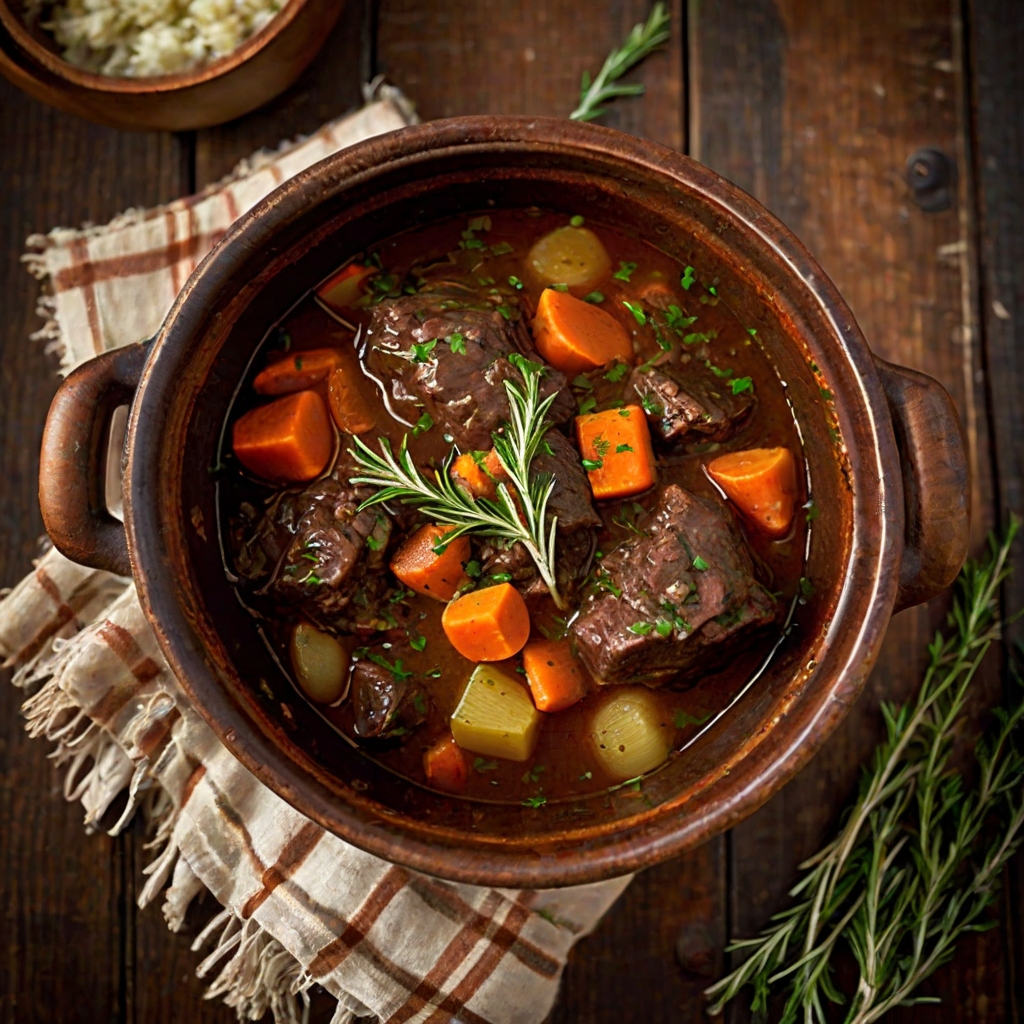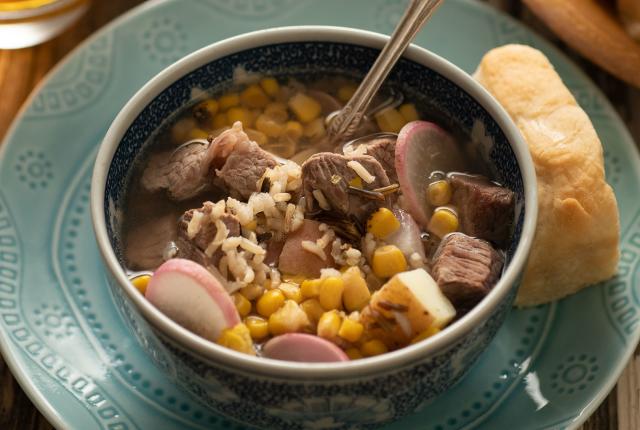
A Taste of Tradition: Authentic Native American Bison and Wild Rice Stew
The vast plains of North America once thrummed with the thunder of bison hooves, a living embodiment of abundance and sustenance for the Indigenous peoples who shared their land. For millennia, these magnificent creatures, alongside the resilient grains of wild rice, formed the cornerstone of many traditional diets. The act of preparing and sharing food was not merely about survival; it was a deeply spiritual and communal practice, weaving together generations through shared stories and flavors. Today, we can honor this rich heritage by recreating a dish that encapsulates its essence: Authentic Native American Bison and Wild Rice Stew.
This stew is more than just a meal; it’s a culinary journey back in time, a connection to the ancestral wisdom of those who lived in harmony with the land. It’s a testament to resourcefulness, utilizing ingredients that were readily available and prepared with techniques honed over countless seasons. The bison, lean and flavorful, provides a robust base, while the nutty, earthy wild rice adds a unique texture and depth. This is not a dish to be rushed. It’s a slow-cooked symphony of flavors, allowing the ingredients to meld and mature, creating a comforting and nourishing experience that nourishes both body and soul.
The Significance of the Ingredients:

-
Bison (Buffalo): For countless Native American tribes, the bison was a sacred animal, providing not only food but also hides for shelter and clothing, bones for tools, and sinew for cordage. Its meat, leaner than modern beef, offers a rich, slightly sweet, and gamey flavor that is distinct and deeply satisfying. The traditional preparation often involved utilizing all parts of the animal, reflecting a profound respect for its life. In this stew, the bison’s lean cuts, when slow-cooked, become incredibly tender and imbue the broth with an unparalleled depth of flavor.
-
Wild Rice: Often referred to as "manomin" or "the food that grows on water," wild rice is not true rice but the seed of an aquatic grass that thrives in the shallow lakes and slow-moving rivers of North America, particularly in the Great Lakes region. It was a vital food source for tribes like the Ojibwe, Dakota, and Menominee. Harvesting wild rice was a labor-intensive and sacred process, often involving paddling canoes through the waterways and gently bending the stalks to knock the ripe grains into the canoe. Its unique chewy texture and distinct nutty, earthy flavor add a sophisticated complexity to the stew, distinguishing it from stews made with cultivated grains.
-

Root Vegetables: The earth provided a bounty of nourishing root vegetables that were integral to Native American diets. Onions, carrots, and celery, while perhaps not always native in their modern cultivated forms, represent the spirit of using readily available, grounding vegetables that add sweetness, aroma, and body to the stew. Historically, tribes would have incorporated a wider variety of native tubers and roots, but these common vegetables serve as an accessible and flavorful foundation for this interpretation.
-
Herbs and Seasonings: The use of herbs was often tied to traditional knowledge of their medicinal and culinary properties. While specific herbs varied by region and tribe, the principles of enhancing flavor through natural aromatics remain constant. The addition of bay leaves, thyme, and perhaps a touch of sage evokes the earthy, forest-like aromas that would have permeated traditional cooking fires.
The Art of Slow Cooking:
The essence of this stew lies in its slow cooking process. This method allows the tough connective tissues in the bison meat to break down, resulting in incredibly tender morsels. It also gives the wild rice ample time to absorb the rich flavors of the broth and vegetables, developing its characteristic chewiness. This patient approach is a reflection of a time when meals were prepared with intention and without the pressure of modern-day haste. It’s an invitation to slow down, to be present in the kitchen, and to appreciate the transformation of simple ingredients into something truly special.
A Dish for Gathering:
Historically, meals like this bison and wild rice stew were central to community life. They were prepared in large batches to feed families and extended kin, often during seasonal gatherings or after successful hunts. The act of sharing a communal pot of stew fostered connection, strengthened bonds, and passed down cultural knowledge. Even today, this stew serves as a perfect centerpiece for family meals or gatherings with friends, offering a comforting and grounding experience that encourages conversation and shared appreciation.
Adapting and Honoring:
While this recipe aims to be authentic in spirit, it’s important to acknowledge that culinary traditions are dynamic and evolve. Modern access to ingredients and cooking methods allows us to recreate these dishes in our own kitchens. When sourcing bison, look for ethically raised and sustainably harvested options. For wild rice, seek out genuine North American wild rice for the most authentic flavor and texture.
This Authentic Native American Bison and Wild Rice Stew is more than just a recipe; it’s an invitation to explore a rich culinary heritage, to connect with the wisdom of the land, and to savor the profound satisfaction that comes from preparing and sharing a meal steeped in tradition. As you stir the pot and the aromas fill your kitchen, imagine the generations who have gathered around similar fires, their stories whispered in every delicious spoonful.
Authentic Native American Bison and Wild Rice Stew Recipe
This recipe aims to capture the spirit and flavors of a traditional Native American bison and wild rice stew, offering a comforting and deeply flavorful dish.
Yields: 6-8 servings
Prep time: 30 minutes
Cook time: 2.5 – 3 hours
Ingredients:
- 2 tablespoons olive oil or rendered bison fat
- 2 lbs bison stew meat, cut into 1-inch cubes
- 1 large yellow onion, chopped
- 3 carrots, peeled and chopped
- 3 celery stalks, chopped
- 3 cloves garlic, minced
- 8 cups beef broth or bison broth (low sodium preferred)
- 1 cup wild rice, rinsed
- 2 bay leaves
- 1 teaspoon dried thyme
- ½ teaspoon dried sage (optional, for a more earthy flavor)
- Salt and freshly ground black pepper to taste
- Fresh parsley, chopped, for garnish (optional)
Equipment:
- Large Dutch oven or heavy-bottomed pot
- Wooden spoon or spatula
Instructions:
1. Sear the Bison:
- Pat the bison stew meat dry with paper towels. This helps achieve a good sear.
- Heat the olive oil or rendered bison fat in the Dutch oven over medium-high heat.
- Add the bison cubes in batches, being careful not to overcrowd the pot. Sear on all sides until nicely browned. This step is crucial for developing flavor.
- Remove the seared bison from the pot and set aside on a plate.
2. Sauté the Aromatics:
- Reduce the heat to medium. Add the chopped onion, carrots, and celery to the same pot.
- Cook, stirring occasionally, until the vegetables have softened, about 8-10 minutes.
- Add the minced garlic and cook for another minute until fragrant.
3. Deglaze and Combine:
- Pour in about ½ cup of the beef broth and scrape the bottom of the pot with a wooden spoon to loosen any browned bits. This adds immense flavor to the stew.
- Return the seared bison meat to the pot.
4. Simmer the Stew:
- Add the remaining beef broth, bay leaves, dried thyme, and dried sage (if using).
- Bring the mixture to a boil, then reduce the heat to low, cover the pot, and let it simmer gently for 1.5 hours. Stir occasionally to prevent sticking.
5. Add the Wild Rice:
- After 1.5 hours, stir in the rinsed wild rice.
- Cover the pot again and continue to simmer for another 1 to 1.5 hours, or until the bison is very tender and the wild rice is cooked through and has a pleasant chewiness. The exact cooking time for the wild rice can vary, so check for doneness.
6. Season and Serve:
- Remove and discard the bay leaves.
- Season the stew generously with salt and freshly ground black pepper to taste. Remember that bison can be lean, so don’t be afraid to season well.
- If the stew is too thick, you can add a little more broth or water to reach your desired consistency.
- Ladle the hot stew into bowls.
- Garnish with fresh chopped parsley, if desired.
Tips and Variations:
- Bison Fat: If you can source rendered bison fat (tallow), it will add an even more authentic and rich flavor to the stew.
- Other Root Vegetables: Feel free to add other hearty root vegetables like parsnips or sweet potatoes during the last hour of simmering.
- Mushrooms: Sliced cremini or shiitake mushrooms can be added along with the onions, carrots, and celery for an extra layer of umami.
- Herbs: Experiment with other traditional herbs like marjoram or rosemary.
- Spices: A pinch of smoked paprika can add a subtle smoky depth.
- Thickening: If you prefer a thicker stew, you can mash some of the cooked vegetables against the side of the pot or create a slurry of 1-2 tablespoons of cornstarch mixed with an equal amount of cold water and stir it into the simmering stew during the last 15-20 minutes of cooking.
- Serving Suggestions: This stew is hearty enough on its own, but it can also be served with crusty bread for dipping.
Enjoy this taste of tradition!


